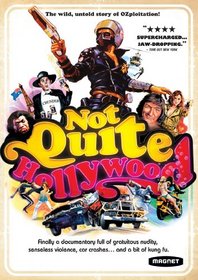| Actors: Jamie Lee Curtis, Cassandra Delaney, Rebecca Gilling, Gregory Harrison, Stacy Keach Genres: Indie & Art House, Special Interests, Documentary Sub-Genres: Indie & Art House, Special Interests, Documentary Studio: Magnolia Home Entertainment Format: DVD - Color,Widescreen - Closed-captioned,Subtitled DVD Release Date: 10/06/2009 Release Year: 2009 Run Time: 1hr 33min Screens: Color,Widescreen Number of Discs: 1 SwapaDVD Credits: 1 Total Copies: 0 Members Wishing: 9 MPAA Rating: R (Restricted) Languages: English Subtitles: Spanish |
Search - Not Quite Hollywood on DVD
  | Not Quite Hollywood Actors: Jamie Lee Curtis, Cassandra Delaney, Rebecca Gilling, Gregory Harrison, Stacy Keach Genres: Indie & Art House, Special Interests, Documentary R 2009 1hr 33min Free-wheeling sex romps! Blood-soaked terror tales! High-octane extravaganzas! Welcome to NOT QUITE HOLLYWOOD, the wild, wonderful story of 'OZPLOITATION' — films. Join QUENTIN TARANTINO, JAMIE LEE CURTIS, DENNIS HOPPER and... more » |
Larger Image |
Movie DetailsSimilar Movies
Similarly Requested DVDs
|
Movie ReviewsEXPLOITATION FROM DOWN UNDER Mark Turner | 10/07/2009 (5 out of 5 stars) "Most people think of two movies when they think of films from Australia. The most popular was CROCODILE DUNDEE, a film which a friend of mine from Australia says most folks there would like to forget. The other is MAD MAX.
This low budget exploitation films kick started the career of Mel Gibson as well as a slew of apocalyptic visions on film that involved car chases in rusted out, souped up, turbo charged vehicles. A world where marauding packs of gun toting savages ruled the streets until the hero came along. But there was more to films coming from Australia than these. And the recent release NOT QUITE HOLLYWOOD celebrates those films as well as informs viewers of gems they might have missed. Comprised of clips and interviews, this well rounded documentary gives us examples of everything from sexploitation films to the already mentioned road chase flicks. The DVD begins in the seventies when the restraints of censorship were somewhat lifted and there was an influx of films that were bawdy but harmless in the long run. Think back to films like CANDY STRIPE NURSES and STUDENT TEACHERS and you get the picture. Films that were the mainstay for many drive-ins across this country were sprouting up in Australia with a decidedly Aussie flavor. But the rest of the world began to pick up on these gems as well. Exploitation films had arrived and were re-dubbed ozploitation. Films like ALVIN PURPLE that told the tale of a young man who women found irresistible, who all wanted to bed, started as far back as 1973. The film was so successful that it spawned a sequel. And many more films featuring over exposed men and women followed. But it wasn't just sex that sold. There were monsters and gore films as well. The suspense film ROAD GAMES starring Stacy Keach and Jamie Lee Curtis kept viewers on the edge of their seat. RAZORBACK had a ferocious oversized boar attacking people. And PATRICK featured a catatonic patient whose psychic abilities were such that he could kill without moving from his bed of blinking. Then there are the action films, most notably those of director Brian Trenchard-Smith. Starting with MAN FROM HONG KONG and later turning out DEAD END DRIVE-IN, Trenchard-Smith gave full blown, blast off the screen action films that had cars blowing up, martial arts battles galore and over the top action. But he wasn't alone. STONE from Sandy Harbutt gave us a new take on the biker film with a decidedly Aussie style. The films discussed here are not to be lost and won't be due in part to those they have influenced. Tarantino for one. The director/writers of SAW for another. Or the terror filled film WOLF CREEK that scared so many just a few years back. All are made by film makers who grew up on these films. This documentary mentions them all and features interviews with Jamie Lee Curtis, Stacy Keach, director Richard Franklin, Dennis Hopper, Barry Humphries, director George Miller, director Russell Mulcahy, Trenchard-Smith and more. It also has film buff Quentin Tarantino giving his take on the genre and why these films are treasures to be found and not forgotten. Each one gives their tales of the early days of the rise of Australian film making, the good the bad and the ugly. Tales of no budget, no release form, no safety minded film makers who just wanted to make something their own. While major releases are hyped and propped up with mega ad campaigns, small exploitation films have always relied on word of mouth to get people to see them. Some do so on DVD (video when they first started), some develop cult followings and some are discovered when documentaries are made about the genre that say "hey, you might have missed this one". The days of the drive-in theater are waning, but not quite dead. But the films that were made for them, the movies that used topics as old as the first story tellers expressed, are still around and available on DVD. This movie praises those early film makers for what they were able to achieve. It's also a guide book for films to seek out. And more than anything, it offers a fun look at the early days of an industry that started with an Aussie outlook that the world eventually adopted and enjoyed. " |















